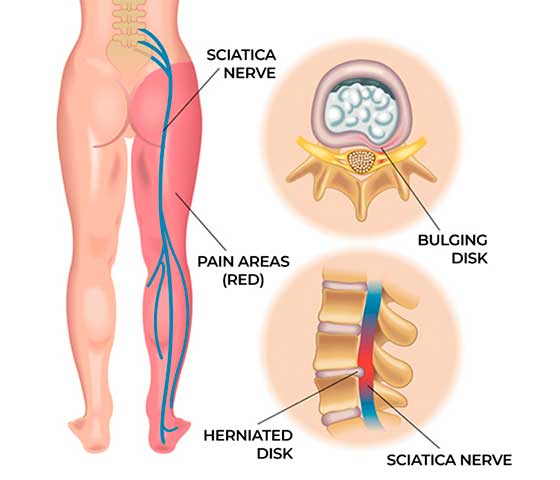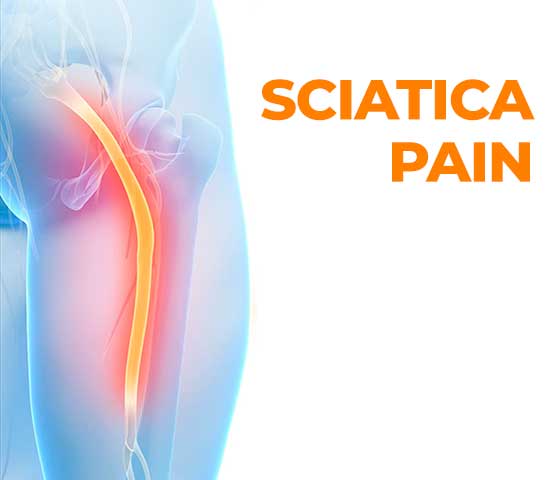Sciatica pain, also known as sciatic nerve pain, refers to pain that radiates along the path of the sciatic nerve, which branches from your lower back through your hips and buttocks and down each leg. This condition can cause sharp, burning, or shooting pain along the nerve path, typically affecting one side of the body.

The main symptoms related to sciatic pain are low back pain, often radiates down the leg. Numbness in the leg or foot, ,muscle weakness in the affected leg, and also, persistent pain when sitting, standing or prolonged movement. Typically, sciatica affects only one side of the body.
Physiotherapy can be highly effective in managing sciatica pain by improving mobility, strengthening the muscles that support the spine, and reducing inflammation. At Revolve Physiotherapy, our team will develop an exercise program tailored to the individual’s specific needs.
Typically releated sciatica pain causes include:
- Herniated Disc: One of the most common causes is a herniated or slipped disc that compresses the sciatic nerve.
- Spinal Stenosis: Narrowing of the spinal canal can put pressure on the nerves.
- Piriformis Syndrome: The piriformis muscle in the buttocks can irritate the sciatic nerve if it spasms or becomes tight.
- Spondylolisthesis: A condition where one vertebra slips over another, potentially compressing the sciatic nerve.
- Injury: Trauma to the lower back or buttocks can result in sciatica.
Here are some steps in physiotherapy treatment for sciatic pain:
Assessment: A physiotherapist will start with an initial assessment to understand the cause of your sciatica, which can include medical history review, physical examination, neurological tests, maging studies (if available).
Treatment Goals: Alleviate pain and inflammation, improve mobility and flexibility, trengthen muscles supporting the spine, correct posture and body mechanics and prevent recurrence.
Treatment varies greatly depending on the specifics of each case, and may include:
Pain Relief Techniques: Application of heat or ice packs or using modalities, such electrical stimulation and ultrasound.
Manual Therapy: Massage to relieve muscle tension and improve blood circulation. Gentle movement of joints to improve their function, specific movements applied to the spine to improve alignment.
Exercise Therapy: Stretching Exercises to improve flexibility and reduce nerve compression. Strengthening exercises to build muscles supporting the spine and aerobic exercises with Low-impact activities like walking or cycling to improve overall fitness.
Posture and Ergonomics Training: Education on maintaining proper posture while sitting, standing, and during activities and ergonomic advice for work and home environments.
Lifestyle and Activity Modifications: Advice on activity modification to avoid positions and movements that exacerbate pain. Also, Encouragement to stay active within pain limits to avoid deconditioning.
Monitoring and Progression: Regular follow-up sessions to monitor progress and adjust treatment as necessary. Also. gradual progression of exercises and activities based on improvement.
Physiotherapy offers a holistic approach to managing sciatica pain. Focusing on pain relief, improving mobility, and strengthening the supportive structures of the spine. Consistency and adherence to the prescribed exercises and modifications are crucial for effective pain management and long-term relief.

Always consult with a qualified physiotherapist to tailor the treatment to your specific needs and condition. By following a structured physiotherapy program, you can significantly reduce sciatica pain and improve your quality of life.
If you experience severe pain, significant weakness, numbness, or loss of bladder or bowel control, seek medical attention immediately. This could indicate a more serious condition requiring prompt medical intervention.
Sciatica Pain Physiotherapy in Milton at Revolve. Don’t wait any more, find pain relief! Call us now 905 864.8181 and talk to one of ours Specialist.
